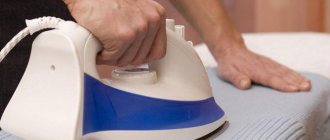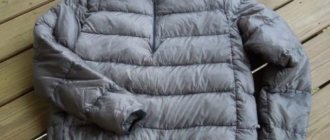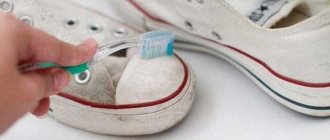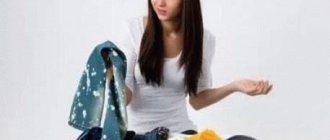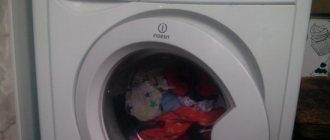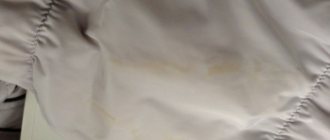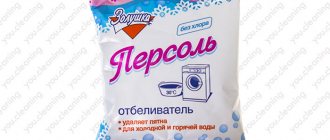Light, airy dresses, exquisite curtains made of flowing organza: many people prefer to refuse all this beauty, fearing the labor-intensive ironing of delicate fabric.
How to quickly iron organza after washing and is it possible to avoid this process altogether?
Ironing secrets will help you achieve an ideal result with minimal time and effort.
If necessary?
When washing and drying organza is done correctly, you can avoid ironing this airy, silky fabric.
So for washing, use only special detergents for delicate fabrics , the water temperature should not exceed 35-40C.
When washing organza in a washing machine, the spin speed should not exceed 500 (or it is better to turn off the spin function altogether).
When washing by hand, it is strictly forbidden to wring out the fabric with your hands. Proper drying will help avoid the tedious ironing process .
To do this, clothes (dresses, sundresses, fluffy skirts) are hung on hangers, and curtains are hung wet on the curtain rod. Organza is dried away from heating devices and direct sunlight.
The video will show you how to wash organza in a washing machine so as not to iron it later:
How to iron organza curtains
The procedure is labor-intensive. To make long curtains easier to iron, do this:
- Place the ironing board near the chair/sofa/table/clothes dryer.
- The lower part of the curtain is placed on it, the rest of the panel is lowered to the floor in front of the board.
- They begin to iron, gradually moving the canvas towards themselves.
- As soon as the ironed part of the curtain reaches the floor at the ironer’s feet, it is moved to the sofa. And the ironing board is gradually moved away from him.
- They act in the same way until the curtain is completely smoothed along its entire length.
- Wide curtains for ironing are folded in 3-4 layers.
How to do it?
There are several ways to iron organza after washing :
- using an iron,
- steam generator.
Let's look at each of them in more detail.
Iron
To achieve perfect ironing results and avoid fabric damage, you must adhere to the following recommendations :
before ironing, be sure to check the cleanliness of the soleplate of the iron (the slightest scratches and dirt leave roughness on the silky surface);- the iron is heated to a certain temperature (100-140C);
- a product made of delicate fabric is laid out on the ironing board with the wrong side (it is not recommended to iron delicate fabric on the front side);
- during the ironing process, the iron is quickly moved across the fabric (without pressure);
- A piece of white gauze, through which thin fabric is ironed, will help protect the organza from deformation.
If the fabric is very wide, it can be laid on the ironing board rolled in several layers.
We use a steam generator
Steam will help eliminate creases and folds and quickly smooth out organza.
Using the steam generator is simple:
- clothes for ironing are hung on a special rack - hangers, curtains on the ledge;
- Using the vertical steam function, delicate fabrics are smoothed in seconds.
To avoid deformation and stains, do not bring the steam generator nozzle very close to the fabric (optimal distance 15-20cm).
Smoothing
So, how to iron organza to avoid fabric deformation and color change.
When ironing, use a warm iron to avoid melting the airy material. The condition of the sole must be checked. It must be clean and smooth because the fabric is sensitive to snags.
Before starting, cover the ironing board with a layer of white cotton material. The second strip is used as an ironing iron. You shouldn’t use colored material, because it can leave stains, and if you put a terry towel on it, the structure will be sealed.
Important! It is prohibited to spray organza with water when ironing. This procedure leads to the appearance of small stains from drops.
You need to move the iron quickly across the surface of the fabric, pressing in each position and not stopping in one place. Go over the remaining bumps 3-4 times. If you “carry” it, the material will lose its shape and you will have to spend a lot of time on restoration. It is recommended to move the iron in the direction of the grain threads.
When dry, crumpled organza does not smooth out well. Only small creases will be straightened out; strong ones will still remain. You cannot turn on steaming to combat bruises. Hot steam negatively affects the material, it turns yellow and waves appear.
To work with large items, such as curtains, place the ironing board next to the sofa, bed or table. The smoothed part is laid out on the bed, and in the last section the board is gradually moved away. Wide fabrics can be ironed in several layers, avoiding the fold area. The fabric is turned and these areas are ironed separately.
Advice! You can use tissue paper as an ironing iron.
Features of ironing depending on the fabric
Temperature conditions and ironing characteristics are determined by the type of organza:
- silk,
- polyester,
- viscose.
Silk
The high cost of silk organza imposes a number of restrictions when ironing :
Only slightly damp fabric can be ironed. If the silk organza is dry, it must be sprinkled with water and placed in a plastic bag for half an hour to evenly distribute moisture throughout the fabric.- Silk organza is ironed only at a temperature not exceeding 140C (or the “silk” option on the iron regulator).
- Silk should never be ironed wet. Firstly, the fabric may change its structure (become more rigid), and yellow spots may appear on the organza.
- Silk organza is ironed only from the wrong side.
- When using a steamer to iron silk, the steam pressure should be low with a fine spray of moisture (otherwise the fibers will lose their strength).
Polyester
Synthetic fibers create not only strong, but also wear-resistant fabric that often does not require ironing. It is enough to hang the wet product, straighten it and let the water drain.
In a situation where, after washing, things made of polyester are still wrinkled, the following recommendations will help to straighten them out :
- Before ironing, the wet item should hang on hangers.
- if we are talking about curtains, they are hung wet on the cornice;
- iron dry fabric at a temperature of 100C (or the “nylon” option on the iron);
- heavily wrinkled polyester is ironed through damp gauze;
- It is not advisable to use a steamer to iron polyester, as the item may lose its shape.
Steam from hot water in the bathroom will help you quickly remove wrinkles and creases from polyester. It is enough to hang a polyester product over a bathtub filled with hot water and leave it like that for half an hour (the door to the room is closed).
Viscose
Soft viscose wrinkles very much after washing, so ironing is a must.
The following tips will help you quickly remove wrinkles from viscose:
- ironing is carried out at temperatures up to 150;
- viscose fibers are very thin, so ironing takes place at an accelerated pace (you cannot linger for a long time and move the iron in the same place);
- viscose is ironed through damp gauze;
- Viscose is never steamed, as the steam leaves streaks on the fabric and stretches it.
Is it possible to iron organza with an iron?
Recommendations for caring for delicate fabrics also include ironing. Usually it is needed for dresses for special occasions.
Before ironing you need to:
- Check the cleanliness of the sole (there should be no scratches, roughness, or deposits on it).
- Study the requirements indicated on the label.
Iron temperature
One of the most important requirements. The heating temperature should be minimal (no more than 140 °C). Exceeding the permissible value is the main reason for the appearance of yellow spots, waves and melted areas.
You need to iron with a protective backing cloth, white cotton cloth (chintz/calico), and gauze. Gauze is more suitable for ironing seams and large folds. To protect the main fabric, it is too thin and easily sticks to the hot sole.
Ironing process
Performed in the following order:
- Turn the washed, slightly damp product inside out (only the seams are smoothed on the front side).
- Place it on a dense backing material (flannelette blanket) between two pieces of white material (moisten the top one with water and wring it out).
- Set the temperature mode.
- Test the heat level by starting ironing from an inconspicuous edge.
- Iron, moving the iron without pressure, staying in one place for 1-2 seconds. Do not leave the device on the fabric when stopped.
Tips and prohibitions
The following tips will help you avoid ironing mistakes:
- Wrinkles can be easily removed by ironing them through damp gauze.
- The temperature regime for organza never exceeds 140 C.
- Organza is ironed intensively, but without strong pressure. Thin, light matter, even if the iron is held in one place for a minute, can change color and structure.
- Strong creases and folds can be effectively removed using a steamer. Exposure to steam is carried out at a distance of at least 15 cm from the material.
- Before ironing, always test the heated iron on an inconspicuous area of the fabric. Particular attention is paid to the first ironing of organza products.
Please note: light, airy organza quickly loses its strength, shape, and appearance if the ironing temperature is incorrectly chosen or the steam generator is not used correctly.
How to iron organza tulle
Airy tulle curtains should only be ironed, following the following recommendations:
- Start ironing immediately after washing. No need to dry. Get rid of excess water by hanging it on a crossbar.
- Set the regulator to the “∙” or “∙ ∙” position (t=90-120 °C).
- Start from an inconspicuous area.
- Iron a moistened piece of cotton material through a backing napkin using the sole attachment. And only from the wrong side.
How to care for organza after ironing
After ironing, dresses/skirts should dry naturally. They should be hung on hangers and left in the room for an hour and a half. Then you can put it in the closet.
Lay the curtains and tulle flat on the bed/sofa for 15-20 minutes. Then hang it in place, carefully smoothing it with your hands. Once a week, go over their surface with a dust brush or furniture broom.
How to iron curtains
The practical application of the rules and procedures for ironing curtains made of various materials allows you to quickly and without unnecessary hassle bring products of simple and complex designs that have different sizes, shapes and bends into proper appearance. Only properly ironed curtains can create comfort and highlight the beauty of the interior. And if housewives usually have no problems with short curtains, then in order to iron large-width curtains, with folds, ruffles, ruffles, edgings, lining or lambrequins at home, you will need not only a lot of patience and skill, but also knowledge. First of all, they relate to the preparation of the workplace and the sequence of heat treatment. It would seem that if you have a steam generator or steamer, problems should also not arise. But they are only recommended to be used exclusively in well-ventilated rooms (so as not to create excessive humidity), and also only if there is quite a lot of time. As practice shows, the correct approach to ironing takes less time than ironing with steam or a combined method. It would also be optimal to have an assistant, but you can do without one.
In such a situation, you need to act in the following sequence:
- Prepare the area for ironing. It should be well lit. In addition, you must be able to move freely.
- If the curtain is large, then place several chairs or a table next to the ironing board, on which you can lay out the already ironed curtain.
- You need to start ironing curtains with frills and edging. Following them, iron the straps, eyelets and areas near the eyelets. If the curtain has a lining, then it is this that should be smoothed out following the listed elements.
- Embroidery and embroidery are ironed from the inside, pressing the iron with force.
- If the specified elements are not on the curtains, then ironing begins from the top of the product. If you are right-handed, then the iron should be on the right side, with its cord located between you and the board. If you are left-handed, then place the iron to your left, but keep in mind that its cord should also be closer to you.
- It is convenient to straighten curtains from the corner that is closest to you, moving downwards.
- Ask an assistant to carefully hold the ironed curtain with your hands, or place it on the table (the backs of chairs). You can also wrap the curtain on a soft round roller.
- Iron the entire curtain, moving downwards in careful, consistent movements.
- Pull the restrictive tape (if there is one in the design) or assemble the curtain with tucks in the right places.
- Hang the curtain in place and, if necessary, run the iron along the bottom of it again.
We recommend: Washing powder: the most popular brands and manufacturers
Operations with the curtain, performed in the given sequence, will allow you to easily smooth out a curtain of a simple design.
Smoothing out coattails, frills and folds
Most curtains have folds, folds or frills that reflect the style of the product, making the curtains a rich decoration and part of the designer’s interior design. But sometimes it can be very difficult to smooth them out, especially with an iron. A steamer will come to the rescue; using it in a matter of minutes, you can give the product the desired look.
But if there is no such device, then you will have to tinker with a regular iron. And the most difficult thing in this matter will be ironing the bases of the folds. This must be done with maximum diligence, because the most noticeable untidiness is the poorly ironed top of curtains and drapes. In most cases, ironing of these elements is carried out exactly repeating the ironing of classic curtains, evenly moving the fabric away from you and working through the width of the product.
As soon as the product has been ironed to approximately two-thirds of its length, it can be hung on the cornice, and further ironing of the bottom can be done until the fabric is completely leveled.
It is correct to smooth out frills and tails to the middle. It is important to take into account that the leveling of the panels must be done along the grain thread. You can determine it by pulling a piece of fabric in different directions with both hands. If the fabric gives in, then you pull the cross thread; if you couldn’t stretch the fabric, then it’s a lobe thread. Most often, curtains are sewn using a single thread, but there are options for a set of panels that are sold “widthwise”. This is where the lobe thread can have a different position in relation to the pattern or relief knurling.
Tidying up the soft lambrequin
But this is not enough if you need to tidy up the soft lambrequin. As practice shows, this part of the decor is easiest to smooth out using a steam generator or steamer. But it’s no more difficult to tidy up a lambrequin with a simple iron. The basic rules for ironing this element are as follows:
- The product should be ironed along the grain, and this applies to lambrequins made on the bias from any fabric. Violation of this rule can lead to the fact that the folds on this element, which bring solemnity and richness to the atmosphere, will lose their shape.
- When ironing, try not to use thick backings that can pull the fabric in the wrong direction.
- If the product has decorative trim, be it embroidery, appliques, eyelets or fringe, then first iron the fabric near them.
- First, smooth out all the folds and folds from the inside, and only then proceed to ironing the main part of the product. Try to iron in one direction, moving from the edge to the center.
- The smoothed lambrequin should be hung immediately and, while the fabric has not yet completely cooled, fold the folds.
Ironing temperature
It is logical to assume that the temperature of the iron should be, as when washing, no higher than 40°, but even such low heat can cause harm to the fabric. Some housewives iron curtains without additional protection, but the absence of deformation of the fabric in this case is simply luck. Burning organza is as easy as shelling pears. Making it go in waves is a piece of cake. Perhaps we won’t take risks and turn to the next point.
How to iron organza without an iron
In the following ways.
| Ironed product | Algorithm of actions |
| Items of clothing (fluid skirts, dresses) | Wash by hand or in a washing machine without wringing. Hang on a clothes hanger. Place above the bathtub. The water flowing from them will smooth out unnecessary folds and creases. To enhance the effect, you can steam by turning on hot water. |
| Curtains, tulle curtains | Immediately after the last rinse (without spinning), hang it on the curtain rods. Place rugs or other rags on the floor (to absorb water). Straightens manually by moving your palms up and down. Move without pressing, do not stretch the fabric too much. |
Using a steam generator
It will be needed to remove stubborn creases. It is used for vertical treatment of wet items hung on hangers or curtain rods with dry steam.
Procedure:
- Fill the reservoir with water.
- Turn on the device.
- Wait until the liquid boils (a characteristic bubbling sound will appear).
- Direct a stream of steam at the item that needs to be ironed. Keep the device at a distance of 15-20 cm from the item being steamed.
- Drive the steam generator from top to bottom, smoothly moving along the surface.
Conclusion
The images that can be created with organza curtains are very beautiful, and it would be foolish to abandon their attractiveness just because of the hassle associated with caring for the material. The fabric is quite practical, does not fade, does not collect dust and does not need cleaning for a long time. With high-quality weekly cleaning, you will have to wash organza no more than 2-4 times a year.
Improper care of the curtains quickly leads to their wear, and it will no longer be possible to restore the attractiveness of the curtains. In order for curtains to last for many years and maintain their aesthetics, you need to give them due attention and provide high-quality non-aggressive cleaning on your own or with the help of professionals.
Related article: Restoring parquet: how to restore an old one with your own hands, parquet flooring, repairs and video, which board to use
Recommendations for washing and ironing
Experts advise adhering to the main rule - do not wash thin curtains more than once a season. Despite the fact that washing should give the material its former cleanliness and freshness, in this case washing only aggravates the situation, making the product gray.
But how to quickly iron tulle so that it does not change its original appearance?
Below are basic recommendations on how to properly iron and wash curtains:
- Before you start washing, you need to soak the tulle in soapy water, in which a tablespoon of salt and the same amount of soda must first be dissolved. This solution allows you to cope with stains, but if the contamination is strong enough, you will need to change the water frequently.
- After pre-soaking, you should start washing. To carry out this manipulation, you need to pour warm water into a large container and add powder there. It should be borne in mind that you cannot rub the product; you are only allowed to raise and lower the tulle. After this, you should rinse the curtain several times in clean water. Under no circumstances should you wring out the curtain, as this will deform the delicate product and spoil the embroidery.
- You can also use the help of a washing machine, where you need to turn on the delicate washing mode.
- How to iron curtains after washing? After the curtains have been washed, you should hang the damp curtains straightened out on the curtain rod. If everything is done correctly, you won’t need to iron the curtains. If this becomes necessary, you will need to iron the curtain with a non-hot iron.
In order to iron the curtains correctly, you will need to wrap them in cotton fabric and iron them. The temperature should not be higher than one hundred and twenty degrees, otherwise stains will form on the curtain that will be impossible to remove.
According to experts, it is most difficult to iron a product made from the finest material. For example, how to iron organza so that it does not fade or become deformed?
Ironed curtains should be hung up immediately, as they wrinkle very quickly, especially those made of polyester materials.
If stains occur, you can simply repaint the tulle. For this purpose, you will need to buy fabric dye, which is sold in every hardware store.

